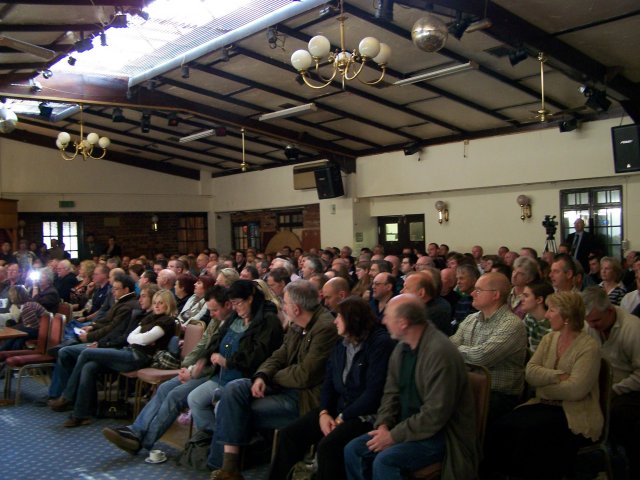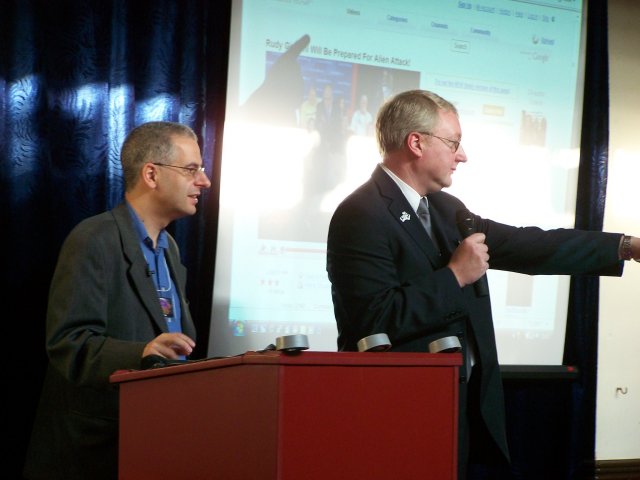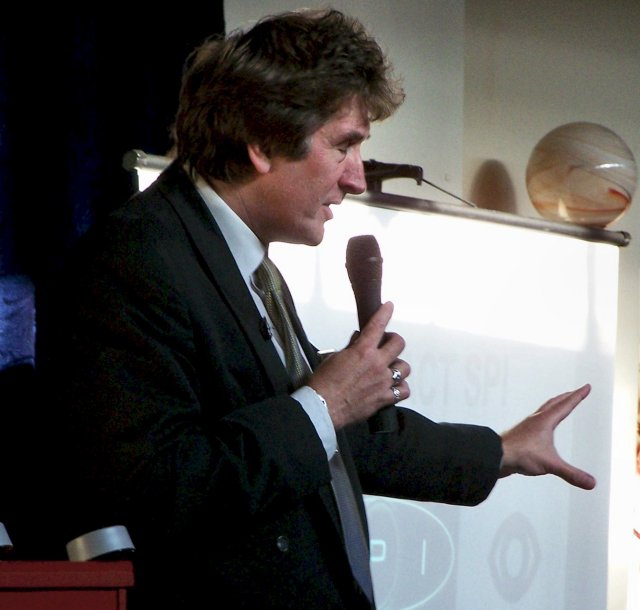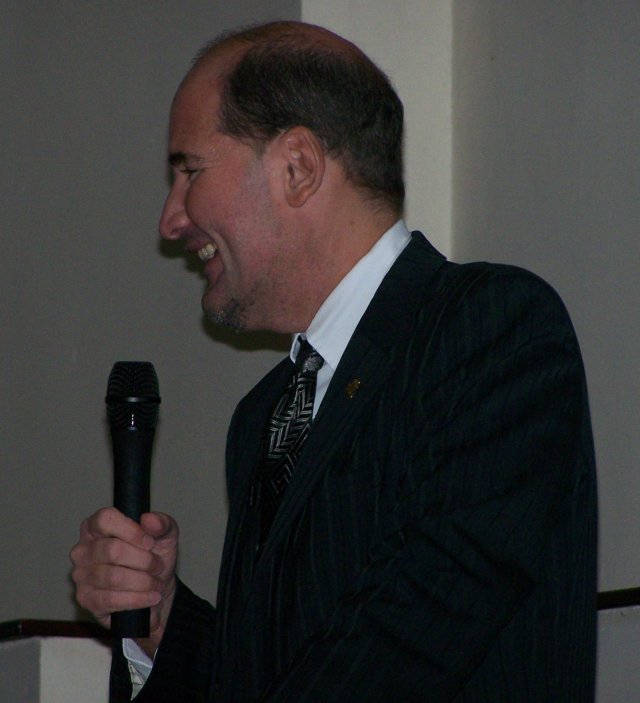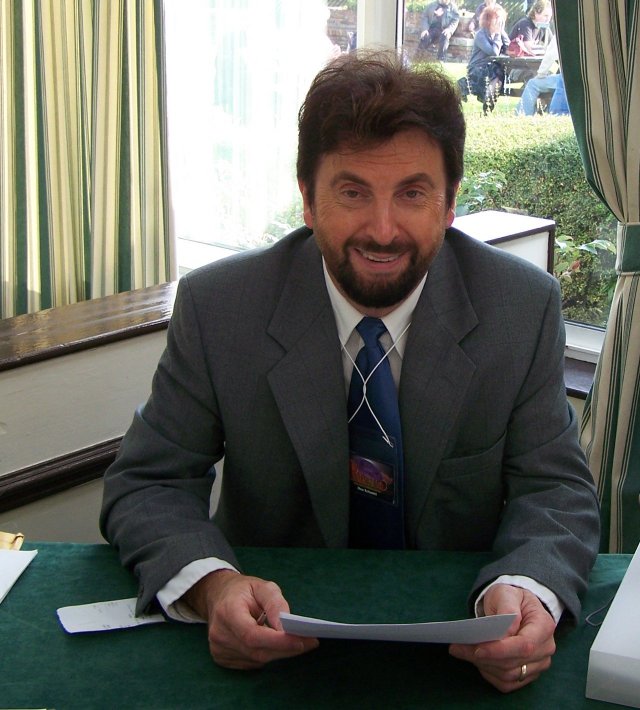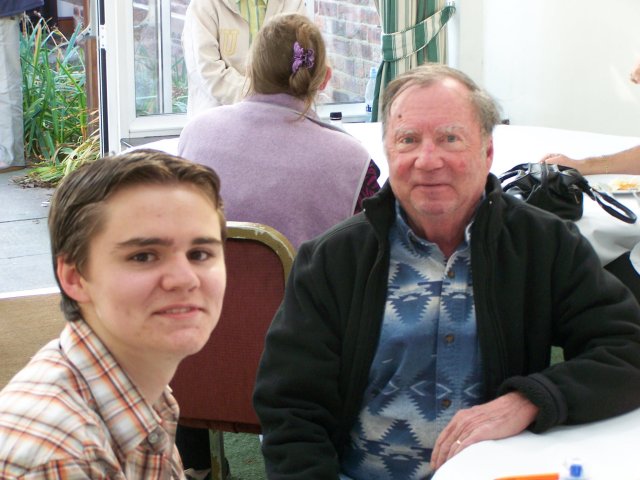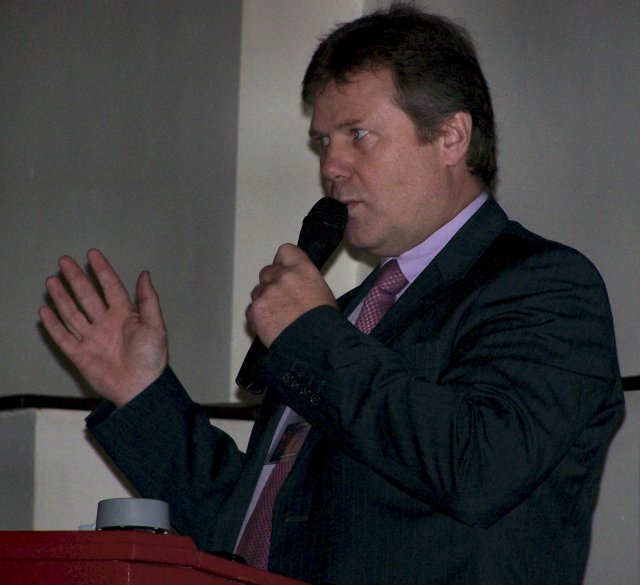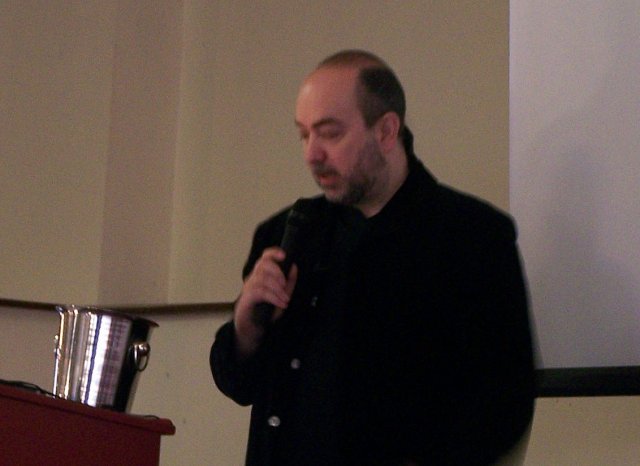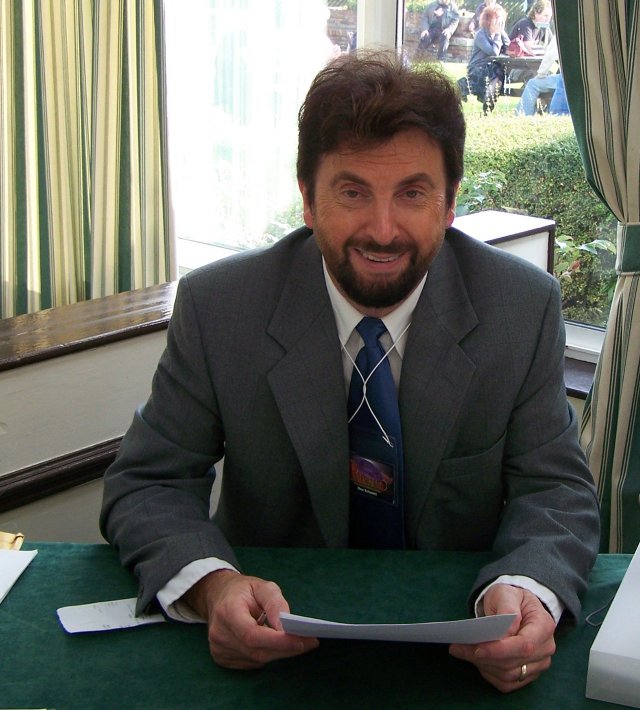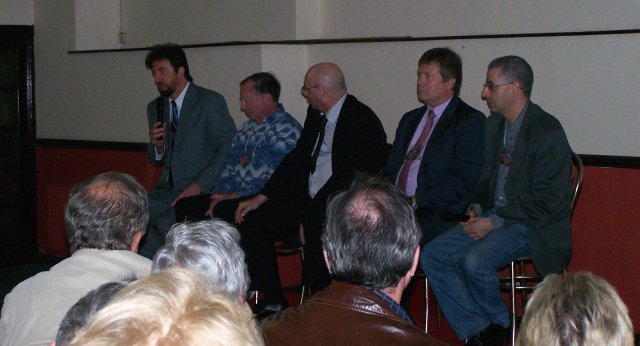|
‘ROSWELL 60’ The Parkside Hotel, Pontefract, UK 20th-21st October, 2007 “The Rebirth of British Ufology”
A new, larger venue and a line-up of top speakers saw UFO Data Magazine’s annual conference go from strength to strength. Pontefract may not be the UFO capital of the world, but the small, Yorkshire town’s Parkside Hotel hosted the largest UFO conference in the UK for years. Over the weekend more than 500 delegates passed through the doors and they enjoyed all of the lectures that were presented by our host, UFO Data Magazine features editor, Philip Mantle. The first speaker on Saturday morning was Nick Pope. We all know Nick as the former head of the Ministry of Defence’s UFO desk in the 1990s. His talk asked the question What Would Happen if Roswell Occurred Today?
Is there a contingency plan for UFO crashes? According to Nick, no there is not. He finds this very disturbing, that nobody in government appears to have even considered what to do in the event of the crash of an extra-terrestrial vehicle. How would we deal with an alien invasion? Could we possibly stand up to beings that possess the technology to travel between the stars? Nick thinks not. He believes that we would stand no chance against such an advanced species if they came here with belligerent intentions. What about a peaceful first contact scenario? Nick reckons that such a meeting would inevitably be under their terms and not ours. What could we possibly offer them? What could they want from us? Nick believes that such a summit would result in an exchange of technology, cultural information and examples of human and alien art. Nick believes that first contact will most likely happen via the Search for Extra-Terrestrial Intelligence (SETI). Professor Ian Morison of Jodrell Bank might disagree with that, recently suggesting that direct contact is most likely to happen with a physical landing rather than a radio message, like the kinds for which SETI are looking. That said, Nick believes that SETI and ufology should work together. We are both looking for the answer to the same question, after all: Are We Alone? According to SETI, if a real, extra-terrestrial signal was found and verified by several different observatories, there would be no cover-up – everybody would be told about it. We’ll see. One question is: Should We Send a Message Back? Should we expose ourselves to the outside universe? Well, we’ve been doing that ever since we first began transmitting radio and television signals so they know we are here anyway. So, what would happen in the event of the crash of a UFO? Well, it would depend on where the crash happened. Nick said that the official reaction to the crash would be different if it crashed in a heavily-populated area rather than a more remote region. He said the first to respond would likely be the police and emergency services, as they would be the ones called by any witnessing members of the public. The area would be cordoned-off and treated like any ‘regular’ plane crash. Essentially, it would be treated as a crime scene and unauthorised people would not be allowed to tramp around the area, destroying or removing evidence. At some point, the military would be called in under a protocol known as ‘Military Assistance to the Civil Power’. Armed forces personnel would operate under the jurisdiction of the civil authorities. There could be a potential biological hazard from extra-terrestrial germs or even the aliens themselves, if any are present. Would we be able to interact with them physically? Would we have any resistance to the micro-organisms they may carry? Bio-hazard and/or radiation teams should be brought in, just like in the event of a chemical/biological terrorist attack or other emergency. Nick believes that contingency plans should be drawn up using common sense and all the available scientific data. If no plan is available, any situation could quickly run out of control because of inadequate preparations. A standard operating procedure (SOP) should be made available to all civil authorities. On the part of the Ministry of Defence (MoD), the UFO desk would probably be brought in first, depending on the time of day, although there are no plans for what would happen after that! We have an SOP for plane crashes, but not for UFO crashes. Why not? Nick asked. The government, Nick said, operates under a creed known as ‘A Culture of No Surprises’. This means that politicians need to be told about what is going on. This is why whenever something happens, there is always a politician (usually the ‘on-duty minister’) on the TV or radio news ready to comment, perhaps albeit briefly, and appear to have the situation under control. A briefing would then be given to ministers, senior civil servants and high-ranking members of the military and a document would be drawn up detailing the known facts, any recommendations and presentational issues (how will it look in the media). This document may be made available to the public or it may not. Nick believes that the public would be informed, mainly just so that the government appear to be in control of the situation. Information would be released to the relevant departments with answers to certain questions laid out. There would also be what are known as ‘If Pressed’ responses. This would be information that the government would rather not disclose, but would if a particularly eager journalist demanded it. The phrase ‘extra-terrestrial’ would likely not be used in any early statements, with more generic terms about the crash and the actions undertaken. A decision would have to be made about notifying the Queen and the possible recall of Parliament, if it is not in session. Nick thinks that a cover-up would not happen, although he admitted that, if it were up to him and depending on the scenario, he might try and keep it from the public. The technology that the crashed object contained would be invaluable to the national interest. If we could study and develop it for our own use, we could be the dominant power on the planet. Scary thought! In all, Nick is of the opinion that these issues need to be resolved and that proper procedures need to be put into place for a Roswell-style event. He has considered drawing up a plan himself and offering it to the government. Nick’s talk got the conference off to a terrific start. After a short break, Malcolm Robinson took the stage. A popular speaker, Malcolm’s sense of humour always pleases the audience. Today, he was talking about one of the most famous cases in British ufology: the Robert Taylor case from Livingston in 1979.
Bob Taylor was a gardener from Perthshire, Scotland, and he had also been a tank driver in the Second World War. After the war, he helped in the building of Livingston New Town, in West Lothian, and lived there until he died on March 14th, 2007. He had no interest in UFOs whatsoever until the 9th of November, 1979. That morning, he set off with his red setter, Lara, in his Land Rover pick-up to check on the Dechmont Woods, where he was a forestry worker. He had made the same journey innumerable times, but today would be different. He parked the van and set off into the woods with Lara. As he entered a clearing, he saw, twenty to thirty yards away, a domed or circular-shaped with a flange running around the centre. At times parts of the object appeared to become invisible. Lara was barking like crazy, but Robert stood, transfixed by the bizarre contraption. He said that everything went quiet – a motorway ran close by and he could no longer hear the cars or any noise from the forest. Suddenly, two round balls dropped down from the UFO, hitting the ground with a strange, sucking sound. They resembled those spiky sea mines from the war that are now to be found in many seaside resorts with kids clambering all over them. They rolled towards him and extended rods which hooked into his trousers at the hips, ripping the thick, serge cloth. They then began dragging him towards the UFO! As he lost consciousness, he remembered an acrid, burning smell and an odd whooshing noise. When he came round, the UFO, along with its spiky companions had gone. Bob had a terrible headache and he was extremely disoriented. He staggered to his truck and tried calling for help on the radio, but found he couldn’t speak. Leaving the van, he made his way home on foot and was in such a state that his wife thought he had been attacked (which he had, but not in the way she thought!). He told her he had been attacked “by a spaceship.” He called his supervisor, Malcolm Drummond, who went to check the area of the incident. He found a series of depressions in the ground of two types. There were two rows of ladder-like marks and these were surrounded by two trails of holes, forty in all, one extending clockwise and the other trail going anti-clockwise. The tracks were depressed into the grass of the clearing, but they made no marks on the ground. The holes were shallow and in several areas, grass around the holes had been sheared off. Drummond was convinced that something had landed in that clearing. The local police looked into the case and they were baffled. They checked all types of machinery that might have left the marks in the clearing, but drew a blank. No helicopters had been in the area and no forestry work had been undertaken. They accepted that Bob believed what he saw, but they were at a loss to explain it. His case was treated as an assault, due to the cuts and grazes he had suffered and his torn clothing, and sent the trousers to the forensic lab. All they could confirm was that the cloth was not torn by any forest debris, such as broken branches, or by barbed-wire fencing. Malcolm then played a video from a Scottish television programme about the incident. It was called The West Lothian Question and was recorded just before Robert died earlier in the year. We heard from Bob himself and also from his local doctor, who vouched for the forester’s integrity. Malcolm then told us of the debunking attempts by Steuart Campbell, a former member of BUFORA. Campbell first tried to pin the blame on ball lightning. When it was pointed out that the weather that day was not conducive to the appearance of ball lightning, he came up with the theory that what Bob saw was an astronomical mirage of Venus and Mercury! Although Venus and Mercury were above the ‘official’ horizon at the time, Malcolm found that they were not visible from the clearing where Bob’s encounter took place. Campbell also suggested that the mirage caused Bob to suffer an epileptic seizure, resulting in his blackout. There has been no history of epilepsy in Bob’s family. Fortean researcher, Duncan Lunan, posited that what Bob stumbled across was a ‘wheelbarrow’ bomb disposal device. These can run on caterpillar tracks and some have legs. Clearly this is not likely. What would one of those contraptions be doing in a Scottish wood? Some time after the incident, Livingston Council installed picnic tables in the forest and used the UFO incident in an attempt to popularise the area. In 1992, Malcolm’s organisation, Strange Phenomena Investigations (SPI) assisted with having a plaque commemorating the event being placed on the site. Numerous plaques have been set onto the cairn there, but they keep being stolen! In the same year, 1992, a psychic visited the site and claimed to see the face of a Grey alien in the trees and a red ball moving through the forest. Psychometry, the psychic reading of objects connected to an event or person, was tried on Bob’s trousers. One psychic, admittedly familiar with the case, described Bob’s experience in detail. Another, also with knowledge of the event, saw three people coming towards Bob. They stuck a needle in his eye and he dropped to the ground. Lara, Robert’s dog, was also rendered unconscious. They also warned Bob about something that would happen in six years. The final psychic, who had no familiarity with the case, held the bag that had contained the trousers and said that Bob had ‘fought for his life’. A ball and a Land Rover were seen and Bob was dragged towards something. He hit his head on something and was raised into the air and pinned to a tree. Bob was traumatised and lost the power of speech. Malcolm admitted that this psychic got some things right and other things incorrect. Robert later moved to another village, but strange events seemed to follow him. A crop circle appeared in a field close by and UFO sightings increased in the area, although Bob did not report any. Malcolm is convinced that Robert Taylor was telling the truth about his experience and that something truly bizarre happened to him. Malcolm’s lively and entertaining talk ended and it was time to break for lunch. As our delegates enjoyed their break, there was a change going on in the conference hall. Sunlight streaming through the ceiling windows had obscured much of the screen upon which slides and videos were projected. So we moved the stage and rearranged all of the seats so that this would not be a problem for the rest of the conference. Popular German researcher, Michael Hesemann, hit the stage at 2pm. The subject of his talk was ‘KGB UFO Secrets’. This had nothing to do with the popular television special that was hosted by Roger Moore. Michael said that this was a complete fabrication and he provided an explanation: One document used in the show described the 1968 deaths of scientists after a UFO crash. The document was marked with ‘Russian Federation’. In 1968, it was the Soviet Union, not the Russian Federation. The video of the Soviet retrieval team depicted Hummers. This kind of vehicle did not exist in 1968. In fact, they did not enter usage until 1985. UFO footage reportedly from a MiG fighter actually came from an F-16. The ‘top secret medical facility’, where an alien autopsy was filmed, was actually rented for the television show.
Michael spoke to many Russian officials, including Colonel Marina Popovich. She was one of the Soviet Union’s top test pilots and was married to cosmonaut, Major-General Pavel Romanovich Popovich. In 1991, KGB UFO files were released to her husband and Michael received a copy of these files from her. The files included lots of UFO reports, including many over Soviet nuclear facilities with many credible witnesses. Michael then showed the conference some video evidence. The first was from the filming of a musical concert. As a lovely, young lady sang a song, the cameraman was intrigued by a strange object in the sky. Another video from 1990 captured a cigar-shaped object and another from 1993 captured a strange light. Photographs of a UFO from a northern rocket base were also shown. General Popovich described how, in 1978, he saw a white triangle while flying over the Atlantic at 36,000 feet. The speed of the object was estimated at 900kph. A clip of the object was played and the triangle is clearly visible. In 1981, Salyut-6 cosmonaut, Vladimir Kovalyonok described sighting a UFO as he orbited over South Africa. An elliptical object flew in front of their craft before ‘exploding’ into golden light. Then two golden spheres appeared in a different position. As they crossed the terminator into night, the objects vanished. In 1991, Mir cosmonauts filmed a cigar-shaped object during the approach of their support capsule. The crew were convinced it was not part of a man-made spacecraft or any other form of space junk. In 1990, during a Soyuz mission, Gennady Strekalov saw a sphere for about ten seconds. He described it as glittering like a Christmas tree decoration. He reported is as ‘a strange phenomenon’, rather than as a UFO. Other Mir missions have also reported UFOs flying in formation above the Earth. Marina Popovich has found over a hundred reports from high-ranking military officers. One pilot encountered a UFO and requested permission to open fire. The object approached the jet fighter to a distance of only 100 metres. Instead of opening fire, the pilot shot a photograph of the object. Then the UFO flew vertically at great speed. The pilot described it as being about 100 metres in diameter. The commander of the Soviet airspace between the Urals and the Pacific, a vast area, spoke of numerous UFO encounters by his pilots. UFOs were picked up by automatic weapons systems, but when they locked on, they failed and became inoperable. UFOs were also seen to jump to different positions in the sky just as Soviet jets attempted to open fire. Michael explained that the Soviet Union had many official study groups devoted to UFOs. Their task was to find out how these objects operated and to see if such technology could be incorporated into the national defence. Unfortunately for them, they were unable to accomplish this, but they continued to log reports by military personnel from all over the USSR. Michael said that all branches of the Soviet military had studied UFOs at some point. General Popovich confirmed that UFOs were considered to be a real phenomenon. UFOs have been seen over top research centres and contact had been achieved by gesticulating towards them! As witnesses pointed in certain directions, the UFOs would copy the motion, changing shape as they did so. While this sounds fantastic, Michael made the point that these reports come from highly-respected and reliable witnesses. Their word is to be taken very seriously and cannot simply be dismissed. One thing is clear, the Soviets thought there was something to the UFO phenomenon! After a short break, Roswell researcher Donald R Schmitt took the stage and gave an impassioned lecture. He noted to the audience that as the years went by, more and more of those present during the Roswell Incident of 1947 were leaving us due to old age.
The first atom bomb test was in 1945 in New Mexico. Did it send a beacon to any curious extra-terrestrials out there? Did they come here from many, many light years away or are they from somewhere much closer? Whatever the answer, just two years after that first explosion, the modern age of ufology began. After 1947, it seemed that a veritable alien invasion had begun and pilots were sent up with camera mounted on their P-51s to try and catch images of the ‘flying discs’. The term ‘UFO’ did not enter the vernacular until 1952, by the way. Scientists mused about the possibility that these craft came from Mars or Venus. Of course, this was long before we sent probes to those planets and learned of their inhospitable natures. When the crash at Roswell happened, the military had no idea how to handle the civilian witnesses. It was a completely unprecedented event (note Nick Pope’s lecture earlier in the day!). Sheriff Wilcox was the first authority figure that William ‘Mac’ Brazel went to see about the debris he found on the Foster Ranch. It was Wilcox who suggested that Mac contact the military. The 509th Composite Group, based at the Roswell Army Air Field (RAAF), was comprised of the best military personnel in the world. The finest officers were assigned there, as would be expected for the only atomic bomb group on the planet. They easily knew what a weather or research balloon looked like. Don told us that Sheriff Wilcox had kept a box of the crash debris for himself and the rest was sent to the RAAF. The military used Wilcox to control the civilian element in this unfolding incident. His daughters would later describe what happened when the armed forces descended upon the Roswell city jailhouse. Military vehicles surrounded the building and Military Police (MPs) flooded inside. They grabbed Wilcox and pushed him to the wall, holding him roughly, with his arm behind his back. They asked him where the rest of the debris was and, on retrieving the wreckage, left. Wilcox was never the same again. He never stood for re-election as sheriff. Why would the military act this way to a civilian of all that was in the box were scraps of a weather balloon? Don read a quote from a guard at the P-3 hangar on the base. This was his usual post, but as he approached one night to take up his assigned position, he found himself being warned away by other guards, who told him that if he came any closer, he would be shot dead. A weather balloon under lethal armed guard? Don then showed a photograph of the alleged crash site of the UFO. It is a bluff some two and a half miles from the debris field on the Foster ranch. Timothy Proctor was seven years-old at the time of the incident. Although young, he was an excellent horse rider and often helped Mac Brazel on the ranch. One day, he came home, after having seen the debris field, looking very shaken. He refused to talk about it for many, many years into adulthood. He would even scarper from the house if he saw Roswell researchers such as Don approaching. One day, when his mother was ill, he took her out in his pick-up truck to the bluff some miles from the debris field. This site is about forty miles north of Roswell. Proctor said to her: “Mom, this is where Mac found something else.” Don said that there were many stories from officers and men of the RAAF about being ordered to keep quiet about what they had seen – even if they hadn’t seen anything! One said that he accompanied the ‘bodies’ out of Roswell and that there were actually three crash sites. The cover story for the huge amount of vehicles used was that the general’s furniture was being moved to Fort Worth. A bunch of furniture transported under heavily-armed guard?! Don noted that the debris field was actually located in a different county to Roswell, so why would Chavez county people be sent out to a site in Lincoln County? Roswell fire-fighter, Dan Dwyer, and his daughter, Frankie, both saw the famous ‘memory metal’. This was tinfoil-like material that could not be cut or burned and when wadded, it would unfold without a crease. Such materials are not even available today, let alone for a weather balloon target in 1947! Frankie described the arrival of the military at the firehouse and how the children were bundled into one room and the parents into another. She recalled one officer speaking to the adults, hitting his hand with a baton, and threatening to kill the kids. Then the children were also threatened and told that they would never see their parents again if they ever spoke of what they had seen. Frankie recalled that the officer had a Brooklyn accent. Don sent Frankie ten photographs of officers, after discovering that the ‘baton man’ was a Lieutenant Arthur Philbin. She picked him out of the selection, saying: “That was the man who threatened to kill us!” Frank Joyce, the manager of KGFL Radio in Roswell, was told by Brazel about a terrible smell at the crash site. Joyce suggested that what he had found were monkeys, used in some sort of test gone awry. Brazel was adamant that what he saw were not decomposing monkeys! Don added a note that there were three sites: the debris field, a secondary body site and the final crash site. Walt Whitmore Sr., owner of KGFL, conducted a recorded interview with Brazel at his (Walt’s) home, where he learned that the rancher had seen bodies. The next day, military personnel showed up, grabbed Brazel (who had spent the night) and confiscated the interview recordings. While General Roger Ramey was explaining to the press that all that was found was a weather balloon, Brazel was held for five days and forced to endure interrogations and invasive medical procedures. Before he was released, he was taken over to the KGFL station by MPs, where he told radio listeners that it was just a weather balloon he found. Afterwards, Joyce asked him why he changed his story. Brazel replied to the effect that he and his family had been threatened. “What happened to the little green men?” asked Joyce. “They weren’t green,” was Mac’s famous reply. Later, after heavy rains, Mac’s son, Bill Brazel Jr., would drive out to the debris field and find many tyre tracks, large and small. Obviously a huge operation had gone on here – all for the recovery of a weather balloon. Bill Jr. also saw the gouge in the earth, covering a huge area. A weather balloon does not leave a huge tract of ripped-up earth when it comes down. Years later, archaeologists rediscovered the gouge, measuring the differences in soil density. Don also made the point that one of the incident’s most elusive players, Sheridan Cavitt, the counter-intelligence officer at Roswell, had admitted that what came down could have been a ‘flying saucer’. Don closed his talk with the story of how the Brazel’s ranch house was turned inside out by the military, searching for any remaining debris, even going as far as ripping up floorboards. This happened in 1949, two years after the incident. All this for a weather balloon? Following on immediately from Don Schmitt’s excellent lecture was the undoubted star of the conference weekend, Dr. Jesse Marcel Jr.
Speaking for the first time in the UK, Jesse told of how his father, Major Jesse Marcel, came home one night and got him out of bed. He didn’t know what time it was, but guessed it must have been around one in the morning. In the kitchen there was a pile of junk on the floor. Jesse didn’t recall if the term ‘flying saucer’ was used, but he knew that that was where they thought this material was from. They searched the debris for signs of technology, vacuum tubes, wiring, that sort of thing, and found nothing. His dad told him about the ‘memory metal’, but he did not see it for himself. He described the famous I-beam with purplish symbols inscribed onto the inner surface. It was not toy store tape on balsa wood, as had been claimed. He also saw a black, plastic-like material that has been likened to bakelite. He affirmed that it was not this common material, but only looked like it. In all he saw this wreckage for about fifteen minutes before he helped his father carry it back out to his car. Jesse saw several more boxes of the stuff in there, but didn’t get the chance to examine it. The next day, when he awoke, his dad had gone, taking the boxes of debris with him and he never saw it again. Jesse then told of the low-level flight to Fort Worth, in Texas. The plane was unable to fly at altitude because of the armed guards in the unpressurised cargo hold. He also told of the switch that had taken place in Ramey’s office and that what his father was photographed holding was not what had been in the family kitchen. On returning home, Major Marcel told his family to never speak of the incident again, although years later, Jesse recalled he and his father seeing articles on newspaper stands about the incident and his dad saying that they both knew the real story. Dr Marcel said that the story first got out to the public in 1978, when Stanton Friedman found his dad. After Jesse Sr.’s death in 1986, Jesse Jr. began getting all of the attention. He decided to write his new book, ‘Roswell Legacy’, while in Iraq, where he was a flight surgeon, and, being surrounded by the chaos of war and the death that accompanies it, thought it was time to get his experiences down before he passed away. In 1984 or 85, Major Marcel visited the area of the debris field with a television crew. They asked him if any debris might still be found, but he told them that the whole area had been vacuumed clean. Jesse then told the strange tale of being contacted by somebody in Washington DC. They wanted to see him in a secure room, deep underground. Jesse attended the meeting, where he was told that Roswell was real (not that he needed to be told that!). The mystery man asked if Jesse had ever been threatened, to which the answer was no. The man told Jesse that he may yet be, but that he would try and stop that happening. A bizarre addendum to the Roswell story, I’m sure you will agree. In 1997, Jesse visited Roswell (he now lives in Montana) and was handed some pieces of a radar target. The man that gave them to Jesse was confident that what Jesse handled that night as a child was nothing more than pieces like these. Jesse could not dissuade the man and reaffirmed that he saw no Scotch tape, flowery patterns or balsa wood that night. In fact to suggest that his father could mistake parts of a balloon array for a flying saucer was utter nonsense. Major Marcel had been to radar school and knew precisely what radar targets and balloons looked like. One of Jesse’s passions is astronomy and cosmology. He believes that it is as a result of his Roswell experience that this interest has grown. He showed slides of some beautiful Hubble Space Telescope images. He also quickly reviewed some possible exotic propulsion systems, including Star Trek-style warp engines. He also showed the famous ‘Ramey Memo’, the piece of paper that the general is holding in his office and has been blown-up and analysing, with the words ‘victims’, ‘crash’ and ‘disk’ being discovered. Taking questions from the audience, Jesse said that his mother had never spoken of what happened back then. She was an old-fashioned lady and because his dad had told them never to speak of it again, she had done just that. Jesse also pointed out that back in 1947, his school friends had talked about the crash with him and, later, he had also talked with many officers about the incident. Asked how it felt to hold something that had been manufactured on another world in his hands, Jesse said he felt humbled. To know that you are holding something that came from another civilisation is an astonishing experience. Finally, Jesse was asked, with all the threats that had made to others, if he felt that it was worth the risk in publishing his book. Jesse gave an affirmed yes to that question. It was worth the risk. Jesse Marcel Jr.’s lecture closed the proceedings for Saturday, but that was not the end of our day. Joined by over a hundred delegates, the Speaker’s Dinner was a great success. The hotel provided a carvery service and very nice it was too. It gave everybody the chance to let their hair down a little and get to know our speakers a little better (I found out Malcolm Robinson is a huge Beatles fan, for instance, while Don Schmitt prefers Elvis Presley. Then they asked me who I liked and the conversation quickly moved on to other matters… heh heh.). At the dinner, Malcolm paid the conference organisers a huge compliment and said that, in his opinion, the conference could mark “the rebirth of British Ufology.” Sunday began with new UFO Data Magazine co-editor, Gary Heseltine. Gary is a serving detective for British Transport Police and his talk focussed on how UFO reports should be investigated from a police officer’s perspective. The lecture was called “The Police and the Nature of Evidence.”
Gary said that he treats UFO reports in the same way as he treats any police investigation. When he set up his Police Reporting UFOs (PRUFOS) database in 2002, he had only 6 cases involving 10 police officers. Now that has risen to over 220 cases with about 530 police officers giving information. Gary said that UFO reports consist of quantifiable data, like any other crime report that the police receive. The investigation must analyse all forms of evidence. They include:
Circumstantial evidence can be used to build any given case and some cases are based entirely around circumstantial evidence. It could be that witnesses saw what happened leading up to an incident, but did not see the incident for themselves. The actions of those accused leading up to the incident can be very important when witnessed by others. Witnesses may not have seen the incident, but perhaps heard something or realised that an incident had taken place by other means. A judge once said: “Circumstantial evidence can be excellent evidence providing the pieces of the jigsaw are highly compelling…” Roswell, Gary explained, has a large amount of circumstantial evidence that makes the case compelling. There is also documentary evidence to prove that the military lied about the incident. The police should respond in a proper manner to a UFO report and, if applicable, investigate it further. Gary said that in the past, it depended on the officer that took the call whether it was responded to or even taken seriously. These days, the large control rooms with recorded replies mean that every call is treated equally. Turning to the Livingston case that Malcolm Robinson covered on Saturday, Gary said that PC Bill Douglas had treated it seriously, even saying other officers were afraid to handle it! PC Douglas took a statement from Robert Taylor, which constitutes documentary evidence. He also saw Bob’s serious demeanour and realised that something was very wrong. This is anecdotal evidence. The case had a physical ‘scene of the crime’ – the clearing where Bob had his encounter. The tracks and holes were physical evidence. PC Douglas could find no vehicle that might have made the marks and concluded that whatever it was must have weighed at least three tons. Gary mentioned later that the Bob Taylor incident is now used as a training tool for new police recruits. With regard to the Ministry of Defence, the police may complete an MoD-designed sighting report form and forward it to them. If this is the case, the MoD must respond to the report. Gary noted that the form is quite disgraceful, with no room for full details of the incident. One such report form was completed for a sighting in Bromley, Kent in 2003. The report tells us that a UFO was seen by police officers both on the ground and in a helicopter. The response from the MoD asked if the sighting represented a defence interest. They said that the object had not been detected on radar and therefore the sighting was not of defence interest. Gary asked us to think back to the Cold War and imagine a Soviet aircraft was seen to hover close to a nuclear facility. Military police would look high and low for evidence. All witnesses would be required to give statements, whether military or civilian, and evidence in the form of radar contacts would be seized. After all this, the conclusion would be that it was a major event and definitely in the national defence interest, so much so that it would likely be stamped ‘Top Secret’. Ring a bell? Gary just described parts of what happened at Rendlesham in 1980. That incident was handled differently because UFOs are deniable. Hey, they don’t exist, so who cares, right? Yeah, whatever… Gary then showed some video clips. First up was the Belgian encounter of 1990, when F-16s were dispatched to intercept a triangular UFO. Here we have physical evidence in the form of radar and video footage, there were many eyewitnesses and there is official documentary evidence that the incident took place. Then we saw a clip from Anthony Woods’ remarkable footage from his home in Portsmouth. This was the ‘Big Red’ craft that glided through the daytime sky with flashing lights. Here we have physical video evidence as well as eyewitnesses. The Fleetwood footage of 2003 saw several orange lights appear in the night sky. They manoeuvred into several formations before blinking out. Again, we have video evidence and eyewitnesses. Finally, Gary showed a clip from a camera on board a police car. As the car drives along a road, a bright light appears near the horizon, winking out and reappearing. This is evidence from a police camera and police eyewitnesses. The rules of evidence available to the police should apply equally to UFO sightings as they do to any other incident they investigate. At 11:30, Philip Mantle took the podium and introduced a surprise guest. Spyros Melaris would undoubtedly be the most controversial speaker of the weekend.
Spyros, a filmmaker and illusionist, claimed to be the man who created the Alien Autopsy footage distributed by Ray Santilli and Gary Shoefield. After years of silence, he has decided to go public and the Roswell 60 conference is his first opportunity to spill the beans on this contentious issue. He visited Roswell in 1995 and heard of the UFO crash, but he was sceptical. He then visited an area that was said to have been the actual crash site and said that there was a certain energy there. He was convinced that something did happen there and filmed interviews with many people. He began his talk by taking some tinfoil and wadding it into a ball. He then threw it into the audience. The ball was then thrown again by the man who caught it before Spyros asked the final recipient to join him on stage. On the podium, Spyros had an ice bucket filled with stones. He claimed these came from the Roswell crash site. He took one stone and wrapped it in a small piece of tinfoil. He handed it to the audience member, who reported that the stone was becoming very hot. Thanking the delegate, Spyros sent him back to his seat and then proceeded in handing out stones to the rest of the audience – two stones each. He then asked them to hold the stones together as hard as they could and concentrate on the energy of the stones. Then they were asked to pull the stones apart. Some people could not do this, although some could. Then he owned up, saying that it was simply a trick. The stones were not from Roswell, he had got them from B&Q and had no special properties. It was an illusion, just like the Alien Autopsy film. Ray Santilli had approached Spyros, saying he wanted to make a documentary based around some footage he had. This would turn out to be the infamous ‘tent footage’. Spyros told him that the film was patently faked and that he could do a better one. His version would look real. Melaris approached his friend, master sculptor, John Humphries, who would create the two ‘corpses’ required for the shoot. No claims would be made about the film, with the viewer to decide what they were witnessing. Then at a later date, the illusion would be admitted, along with an explanation of how it was achieved. Unfortunately, Santilli would not follow up the latter part of the plan. Spyros said that the autopsy film required him to undertake lots of research. Every detail must be correct and there must be no anachronisms, items that are ‘out of time’. One such object was the telephone, which Spyros claimed was a ‘fuse’. A fuse is a trick in which an object is placed in such a way that it causes people to take notice and question the film, only to find out that it is possibly correct. The telephone had a curly wire and many people pointed out that they were not available in 1947. Spyros, though, found out that the curly wire was available as an upgrade from 1947, but only those with a keen interest in the subject would have known that. Spyros said the Ant & Dec movie, Alien Autopsy, was a pack of lies. He made everything for the movie, except the alien models. John Humphries played the surgeon and his girlfriend did most of the research. Santilli and Shoefield maintained that there was an ‘original film’ that was ruined, but Spyros said there wasn’t. The ‘original film’ he was shown was the tent footage, a known fake. He completely designed and filmed the alien autopsy film. As for the Kodak authentication of the film, that was achieved by Spyros purchasing a genuine 1947 reel of a baseball match. The leader of that film contained the necessary markers and all they had on were shots of a wall, a door frame and some steps. Spyros cut these out, based his set design on the walls and door frame, and spliced them to the beginning of his film. This leader was the part that was sent to be tested. When asked for more to be tested, it was claimed that they were unprepared to further cut up the film. Santilli made the participants of the venture sign a confidentiality agreement. This made it clear that they would not speak about it until the hoax was made public or a satisfactory monetary return was achieved. With the release of the Alien Autopsy movie in 2005 and Santilli and Shoefield’s claims that the film was manufactured, Spyros felt that the agreement had been broken and he was free to speak. He said that a book is being written about the escapade which would tell the true story of the Alien Autopsy film. Spyros also claimed to have filmed the cameraman’s statement, not Santilli. He said it was not supposed to be released. Spyros travelled to Los Angeles and found a tramp, paid him $500 and asked him to read lines as they filmed him. The tramp turned out to be a former actor and delivered his lines brilliantly. The statement was filmed in normal light, but Spyros turned down the brightness in editing. He knows the name of this tramp and the films he has appeared in. Santilli and Shoefield do not have this information. A lively question and answer session ensued, with some members of the audience becoming vocally upset by Melaris’ claims. Spyros said that he is concerned that because of his film that any genuine footage would be dismissed, but he is optimistic that by proper analysis, the matter of authenticity could be discovered for any piece of film. Asked if he was acting as a ‘double bluff’, or not being who he says he is, Spyros answered by saying that he did make the film and that he has lots of inside information that only those involved would know. He also has documents relating to the production of the film, such as developing lab receipts. Asked if he had any familiarity with the I-beams described by other Roswell witnesses, particularly Jesse Marcel Jr., Spyros said that he had no familiarity with them and that the ‘language’ on the pieces of debris in his film was totally invented by himself. One word was VIDEO and another was FREEDOM. He wrote a full back-story for the aliens, describing their appearance, their world and their language. How much money did Santilli make? Melaris said that ray had told him that they had made very little money and that people were bootlegging the video. Spyros later found that Santilli and Shoefield had made millions out of the film. Some members of the audience became very angry and yelled at Spyros. He apologised if anybody felt conned, but he had set out to make a film, an illusion. He hadn’t even considered the feelings of the UFO community at the time. Michael Hesemann asked how he knew of certain information from the cameraman’s statement that only came to public light after the release of the film. This included the story of a fireball seen over Roswell on May 31st, 1947. Spyros said he had no knowledge of this and that that piece of information came from Ray Santilli, not him. Michael was clearly unimpressed with Spyros Melaris, something he would confirm to me in private later. This brought the morning’s lectures to a close and a buzz of adrenaline-fuelled excitement permeated the conference hall. During lunch, Spyros had many people around him, asking questions and probably demanding answers. Is this man telling the truth? I guess we will find out and be assured that UFO Data Magazine will bring you any news about this explosive development. After everybody had calmed down after lunch, Russel Callaghan spoke of the evolution of UFO Data Magazine. After UFO Magazine closed, Russ felt that some form of magazine be made available to those interested in UFOs. He helped Gary Heseltine start UFO Monthly.com and later set up UFO Data with Michael Buckley and Philip Mantle. It soon became clear to him that people wanted a physical magazine to hold and that was when UFO Data Magazine was born. The first year it was printed at UFO Data’s office in Kippax using high-quality, colour laser printers. Then a risk was taken to have the magazine professionally produced at full size and in a glossy format. It was a huge risk, as the magazine is subscription-based and having full colour, glossy magazines printed is not inexpensive. The subscribers list has grown, though, and Russ is optimistic that one day UFO Data Magazine will appear on the newsstands. Russ was proud to announce that Gary Heseltine has joined with UFO Data as co-editor of the magazine and this can only mean the mag will go from strength to strength. Russ also gave thanks to our cover artist, Rob, who is currently unwell and our thoughts and best wishes go out to him. On to video footage, for which Russ is famous for presenting, he said that the internet is both a boon and a minefield for UFO footage. Each genuine clip on sites like YouTube is accompanied by dozens more hoax clips. Some of these are astonishing to watch, such as the recent Haiti clip and YouTube is replete with many such hoaxes. Russ talked about some of the articles that have appeared in the magazine, such as the F-15 encounter with a strange object over the UK earlier in the year. The audio clip from the pilots was played and it’s impressive stuff. Thanks were also given to contributor such as our resident astronomer, Andrew Pike, and regular columnist, Nick Pope. Both regularly supply excellent articles that are enjoyed by all of our readers. We were also reminded of the bright object that was seen over Leeds in February, 2007. It was captured on a mobile phone video and shown on BBC television. A superb photograph was snapped by Sacha Christie and included in the magazine. One explanation was that it was a sundog, an effect of sunlight refracting through ice particles in the atmosphere. This doesn’t seem to be the case as it was in the wrong position in the sky. RAF Fylingdales was contacted and Squadron Leader Darling was asked if anything had been detected by their sophisticated equipment that day. She said that nothing had been picked up and they had no idea what is in the photograph. A genuine UFO! Some clips were played, including the famous Haiti hoax, a video of some spheres, an arrow-shaped UFO which is probably a hoax and a recent clip from the BBC in which, unknown to the Beeb, Israeli F-16s appear to be sharing the sky with two other disc- or cigar-shaped objects. Russ showed a longer selection of clips from Anthony Woods’ DVD, The Journey, including a longer viewing of the ‘Big Red’ object. Paying tribute to the late, great Graham Birdsall, Russ drew his talk to a close and we had a short break. At 3pm, Don Schmitt began his second lecture of the weekend, focussing on the deathbed confessions of Roswell witnesses.
In the United States ‘deathbed testimony’ is admissible as evidence in a court of law and often more regard is given to these statements because they are usually the final words of a dying person. As with any major event, different eyewitnesses have different perspectives and may see the same event in a different way, or recall it differently. The problem for researchers is in defining the facts from many discrete and sometimes conflicting statements – “Sifting the wheat from the chaff.” While accounts can vary in general terms, they usually describe the same event, but seen from a different perspective. Don said it is an insult to the participants of the Roswell Incident to suggest that they might forget it or get the time of the event wrong by several years, as was proclaimed in the official statement from the US Air Force. He went on to say that UFO researchers are held to a higher standard than those in other fields. The sceptics demand it. If the debunkers are a hundred percent convinced of their cases, why do they continue debate? Is it because they really are not convinced, perhaps? The media always tends to side with the sceptical argument and the general public are inclined to accept the ‘official line’ without question. Governments cannot be trusted because they the record has shown that, time and again, they have lied to protect their own self-interest. Investigators should concentrate on the facts and decide for themselves what they should believe, not blindly accept what others say. The notion that disclosure would send the world reeling into chaos is nonsense. The hundreds of people who were present at Roswell and witnessed things of tremendous import didn’t commit suicide or go crazy or set of on riotous rampages. They got on with their lives. If people could do that sixty years ago, then they most certainly could accept the truth that we are not alone today. Referring back to the deathbed confessions, Don noted that not one of them made reference to a Mogul balloon! He said that his passion for this subject came from the people involved that he had come to know personally. They became his friends and he acted as an honorary pall-bearer at two funerals of Roswell witnesses. Sheriff George Wilcox was the first authority figure approached by Mac Brazel. His granddaughter is Barbara Dugger and she lived with George’s widow, Inez, before she died. Inez told Barbara that it was not a weather balloon that crashed and that the military’s heavy-handedness was the reason that her husband had never stood for re-election. She also told her that George had visited the crash site and seen bodies before being escorted away. He was told that if he spoke, his family would be killed. Don said that a special squad had been brought in to Roswell, similar to the atomic accident team known as S1. This group had the highest security clearance, but everybody at the Roswell Army Air Field already had top clearance, so why the need for this outside team? The squads at Roswell were also segregated during the incident, so that they did not know the men they found themselves with. This would, in theory, result in less chatter between ‘buddies’. Another confession came from a guard at the P3 Hangar 84 area. He said that he saw wreckage and bodies under canvas. Only the heads were uncovered and he described them as larger than normal. He told this to his wife just before he died in 1976. I must apologise at this point in the review, because as Don Schmitt continued his fascinating talk, I was asked if I could drive Michael Hesemann to the airport. He had a plane to catch, obviously. As we headed towards Leeds/Bradford airport, Michael and I chatted about various things, including the presentation of Spyros Melaris. Michael confirmed that he was somewhat sceptical about the man’s claims and I’m sure he wouldn’t mind me repeating that here, even though we were just chatting in the car. As Michael said, if Spyros’ claims are to be believed, then he must have some solid evidence to back up his story. Michael was also sorry that he didn’t get the chance to question him more in a public forum. Hopefully he will get another chance in the future, as Spyros reveals more of his account. With Michael safely at the airport, I headed back and just caught the very end of the Speakers’ Q&A session, with Jesse Marcel Jr., Don Schmitt, Russel Callaghan, Gary Heseltine and Nick Pope. It brought the Roswell 60 conference to a close and all present can be happy that it was a tremendous success.
UFO Data Magazine would like to thank all of our speakers for providing excellent lectures. Thanks go out to our lively delegates who must have had aching bottoms after sitting through all the fantastic lectures. All the staff at The Parkside Hotel deserve great credit for looking after us. Final thanks go to Russ, Mick, Philip, Gary, Rebecca, Danny, Tony and everybody who helped behind the scenes to put together what was undoubtedly the best UFO conference for many years. © Steve Johnson 2007 (Article originally appeared in the November/December 2007 issue of UFO Data Magazine) |
